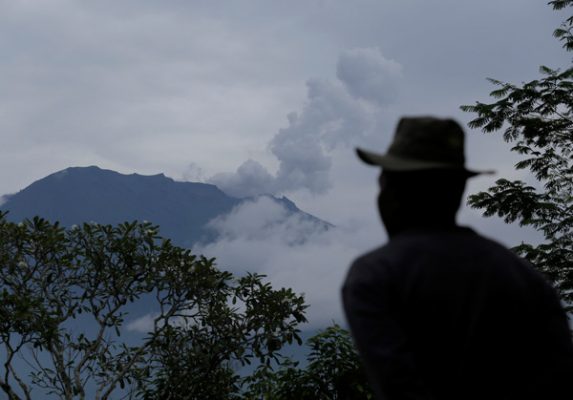
KARANGASEM, Indonesia – Thousands living in the shadow of a rumbling volcano on Indonesia’s resort island of Bali fled on Wednesday as fears grow that it could erupt for the first time in more than 50 years.
Mount Agung belched smoke as high as 700 meters above its summit on Tuesday afternoon, sparking an exodus from the settlements near the mountain.
So far, there are no immediate reports of casualties or damage caused by the eruption.
In a travel notice on Wednesday, Singapore’s Ministry of Foreign Affairs said: “Singaporeans should defer nonessential travel to the affected areas of the island at this juncture. You should also be ready to evacuate at short notice.”
Eruptions could result in ash clouds that could “severely disrupt air travel”, it said. Nearly 1,600 people died when Mount Agung last erupted in 1963.
It stirred to life again in September, prompting about 140,000 people to leave the area. Many returned home after the volcano’s activity waned, but thousands are now fleeing again.
Some 30,000 people remain displaced, officials said.
“There are 13 of us and we’re afraid. Our neighbors have also fled,” said Nyoman Sadi, a local resident who said she was leaving with her family.
Alert level
Disaster officials have warned that fresh activity at Mount Agung could see it blow its top.
But the head of Indonesia’s volcanology center urged people to remain calm and said the mountain’s alert level has not yet been raised.
“Yesterday there was smoke and steam as high as 700 meters, and last night there were tremors for quite a while – around three hours,” Kasbani, who like many Indonesians goes by one name, said on Wednesday.
“The mountain continues to spew smoke, but there hasn’t been any big eruption so far.”
Mount Agung lies some 75 kilometers from Bali’s tourist areas, which attract millions of tourists every year.
Flights have not been affected so far, but officials have estimated that concerns about an eruption over the past few months have cost the island at least $110 million in lost tourism and productivity as many locals moved to shelters.
Indonesia lies on the Pacific “Ring of Fire”, where tectonic plates collide, causing frequent volcanic and seismic activities.
It has nearly 130 volcanoes, more than any other country. Many of them show high levels of activity but it can be months before an eruption.
In 2010, Mount Merapi on the island of Java – considered one of the most active and dangerous volcanoes in the world – erupted after rumbling since 2006, killing more than 300 people and forcing 280,000 to flee.
Mount Sinabung on Sumatra island – which is currently at its highest alert level – has been active since 2013.


